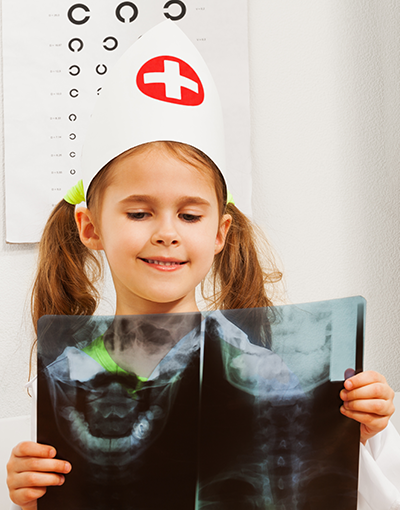
Dental X-rays are important for not only detecting cavities, but also diagnosing and treating conditions that cannot be detected during a clinical exam. At Coulter & Casper Pediatric Dentistry, our dentists utilize X-rays to diagnose bone disease, observe the development of your child’s jaw and teeth, plan orthodontic treatment, and evaluate the results of an injury.
Children’s mouths grow and change rapidly, resulting in children needing X-rays more often than adults. In addition, their teeth are more susceptible to tooth decay than adults. For high caries risk patients, the American Academy of Pediatric Dentistry recommends X-rays every 6 months to 1 year. Children with a low risk of tooth decay may require X-rays less frequently.
In our Washington, D.C. office, Dr. Charlie and Dr. Jerry are particularly careful to minimize the risk of exposure to radiation during X-rays. With modern-day safeguards, like lead aprons, high-speed film, digital X-rays, and thyroid collars, the amount of radiation received in a dental X-ray is extremely low. X-rays actually present a much lower risk than undetected and untreated dental problems.
Our dentists recommend X-rays only when they are necessary to evaluate and monitor your child’s oral health. The frequency of X-rays is prescribed by your child’s dentist and based on your child’s individual, unique needs. We follow the American Academy of Pediatric Dentistry’s guidelines based on your child’s caries risk assessment when taking cavity detecting X-rays at your child’s hygiene appointment.
What are Dental X-Rays?
Dental X-rays are a way to “take a picture” of your teeth to get a deeper look at what is going on beneath the surface. The X-ray emits radiation that is absorbed by the X-ray machine and gives dentists an image of your child’s teeth and jaw. This image provides a deeper understanding of the development of your child’s mouth and any potential issues that may arise. Dental X-rays allow us to provide the utmost care for your child’s smile!
Why Children Need Dental X-Rays
Children’s mouths change rapidly as they grow, so it is important to make sure their smiles are developing appropriately. This includes making sure teeth are erupting correctly, determining if any teeth are missing below the gumline, looking for signs of infection, and evaluating the need for orthodontic treatment.
How Safe are Dental X-Rays for Kids?
At Coulter & Casper, our dental team’s main focus is keeping your child safe. Our X-ray machines put off a minimal amount of radiation, and we take many precautions in our office to lower the risk even further. Our dentists use precautions, such as lead aprons and thyroid collars, to protect your child and shield them from any radiation exposure. Innovations in the industry continue to make dental X-rays faster and safer. Your child’s dentist will only prescribe X-rays as needed, ensuring the safety of your child every time they visit the dentist.
Should I Be Worried About Radiation Exposure?
No, dental X-rays are not dangerous to your child. Through the precautions that we take in our office, radiation exposure poses a much lower risk than leaving tooth decay or dental diseases untreated. As mentioned, our dentists only perform X-rays when necessary. Your child’s safety is our main focus!
When Should Children Get X-Rays?
Children need X-rays more often than adults, but your child’s dentist will base your child’s X-ray frequency on their individual needs. Children who have a higher risk of tooth decay will most likely get X-rays twice a year to monitor their teeth and watch for signs of tooth decay. Pediatric dentists will also administer X-rays to determine the need for orthodontic treatment as their mouth grows and develops.
Different Types of Dental X-Rays
- Bite-wing X-ray: A bite-wing X-ray takes a photo of a specific area of your mouth. Bite-wing X-rays typically take photos of the upper and lower back teeth, showing the exposed tooth, roots beneath the surface, and the jawbone. Taken right in the dental chair, your dentist will have you bite down on a wing-shaped piece of plastic that holds the film in between your teeth.
- Occlusal X-ray: Occlusal X-rays take a look at a section or the entire arch of teeth in the upper or lower jaw. This time of X-rays give pediatric dentists a look into any permanent teeth that have not broken through the surface. To observe tooth development and placement, the X-ray process is similar to a bite-wing X-ray.
- Panoramic X-ray: A panoramic X-ray takes looks at the entire mouth in one continuous image, just like a panoramic photo. Your dentist will have you bite down on a “bite blocker” while the arm of the machine rotates around to record your mouth.
- Periapical X-ray: A periapical X-ray takes an X-ray of a small section of your upper and lower teeth. The X-ray shows everything from the crown of the tooth to the root of the tooth. This type of X-ray gives dentists a closeup to monitor any unusual changes with a tooth.
Contact Coulter & Casper to Schedule an X-Ray
Whether you’re in Bethesda, Friendship Heights, Chevy Chase, or any other Washington, D.C. neighborhood, Dr. Charlie and Dr. Jerry are here for you and your child. Schedule an appointment with us today, and we can help you with your child’s X-ray needs.

 Get directions to our office!
Get directions to our office!